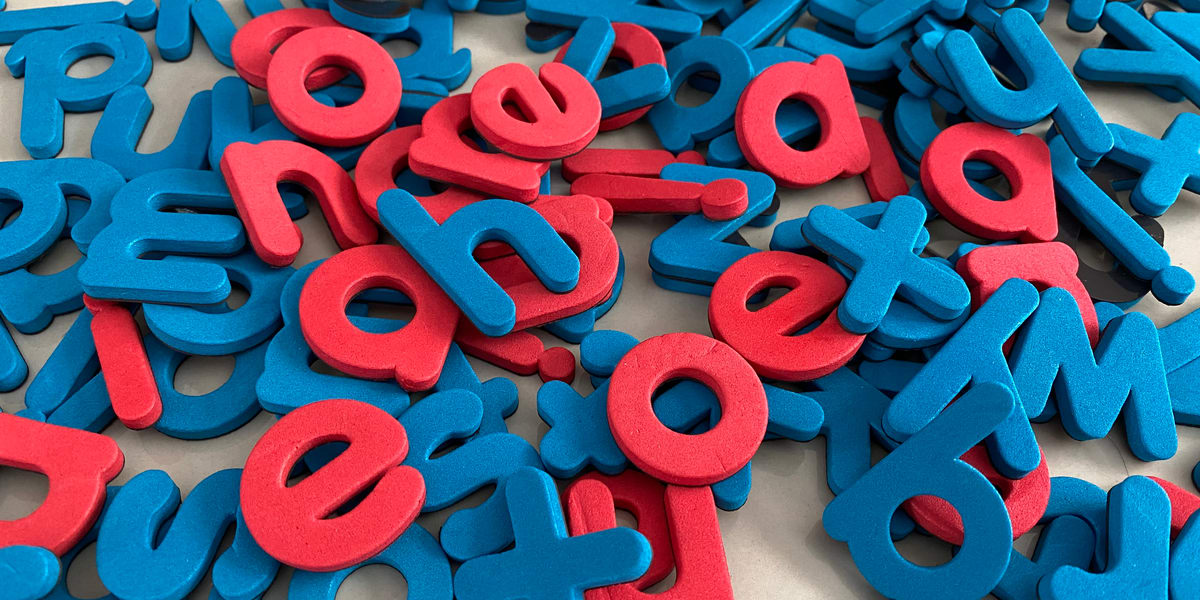
Phonics is an approach to learning English by connecting the letters of the English alphabet to the sounds of the spoken English language. Learning phonics will be easier if you understand the meanings of the words you are speaking, but you are having trouble connecting them to the words on the page. After studying phonics, you will be able to pronounce the words you are reading, spell out the words you are speaking, and understand how the sounds you make while speaking English are connected to the letters on the page.
Familiarize yourself with the difference between a vowel and a consonant. A vowel is a sound you make without making movements in your mouth. You make a vowel sound when you vibrate your vocal chords and allow the sound to pass freely out of your mouth. Vowels usually come after consonants. Consonants are sounds you make by making movements in your mouth, such as closing your lips or touching your teeth with your tongue, to restrict the sound. There are voiced consonants and voiceless consonants. Voiced consonants use the vocal chords, while voiceless consonants just use air. The letters that represent the vowels of the English language are a, e, i, o and u, and occasionally y. The consonants are b, c, d, f, g, h, j, k, l, m, n, p, q, r, s, t, v, w, x, y and z.
Try to pronounce the first group of consonant sounds called the stop consonants. You can make these sounds by building up pressure, completely stopping the sound, then releasing the air. The letters that represent the voiceless stops are p, t, and c or k, and the voiced stops are b, d and g. Try saying "pin" and then "bin" by placing your lips together to stop the air; "town" and then "down" by placing your tongue on your upper gums; "kill" and then "gill" by closing your throat using the back of your tongue.
Learn how to pronounce the second group, called fricatives. Partially barricade the front of your mouth using your tongue, teeth and lips, and push the air through. To make the f (voiceless) and v (voiced) sounds, place your upper front teeth on your bottom lip and push air through, and say "fact" and "vacuum." Place the very tip of your tongue in between your front teeth to make the th sound. Try to say "with" (voiceless) and then "wither" (voiced). To make the s and z sounds, put your teeth together, but don't completely close your mouth. Try to say "sand" and "zoo." Sometimes, the letter c also makes this sound. The sound that is usually associated with the letter combination sh is a bit trickier because it is not always spelled the same way. To make this sound, touch your teeth together but curl the tip of your tongue back a little. Try saying "shoe," "shack" and "shell" (voiceless). Now try to say "version," "vision" "and "beige" (voiced). To make the h sound, you must narrow the airway in your throat. It sounds tricky, but it really just sounds a lot like breathing out forcefully. Try to say "has," hollow" and "hope."
Practice the third group, which are called affricate consonants. This group is a combination of the first and second group. The voiceless version of this sound is commonly associated with the letter combination ch, but it is not always spelled this way. To make this sound, build up pressure inside your mouth while touching your tongue to the ridge on the roof of your mouth nearest to your gums (also known as the alveolar ridge), then release the air. Try to say "chair," "children" and "chipper." The voiced sound is commonly associated with the letters j and g. Try to say "bridge," "jail" and "jello."
Pronounce the sounds of the fourth group, called nasals. Completely close the airflow through your mouth in order to force the sound out of the nose. The sound associated with the letter m is made by touching your lips together and forcing the air out of your nose. Try to say "mellow," "marriage" and "mouse." To make the sound of the letter n, touch the tip of your tongue to your upper gums, then force the sound out of your nose. Try to say "now," "noon" and "narrow." The ng sound is usually found in words that end with ing. Make the very back of your tongue touch the very back of the roof of your mouth, closing your throat. Try to say "lying," "sing" and "ring."
Study the last two groups, which are called liquids and glides. You can make the L sound by touching the tip of the tongue to your upper gums and flowing right into a vowel sound. Say "letter," "lava" and "lovely." To make the r sound, bunch up your tongue to make the middle very tall. Try to say "river," "rascal," "ride." To make the w sound, elevate the back of your tongue to the back of your throat, but do not completely close the passageway. Try to say "wet," "winter," "wilderness." To make the y sound when it is positioned at the beginning of a word, elevate the front of the tongue very high to constrict the airway. Try to say "yellow," "yoyo" and "yard."
Practice your vowel sounds. There are actually many more vowels than there are letters that represent these vowels. The vowels are much easier to learn using a visual representation. See the "Phonetics: The Sounds of American English," University of Iowa, link in resources, and watch the animations and listen to the sounds to get a deeper understanding of vowel pronunciation. Practice these words: leash, tick, play, ten, apple, cot, caught, sunk, little, tether, fur, two, push, low, ice cream, cow and toy.